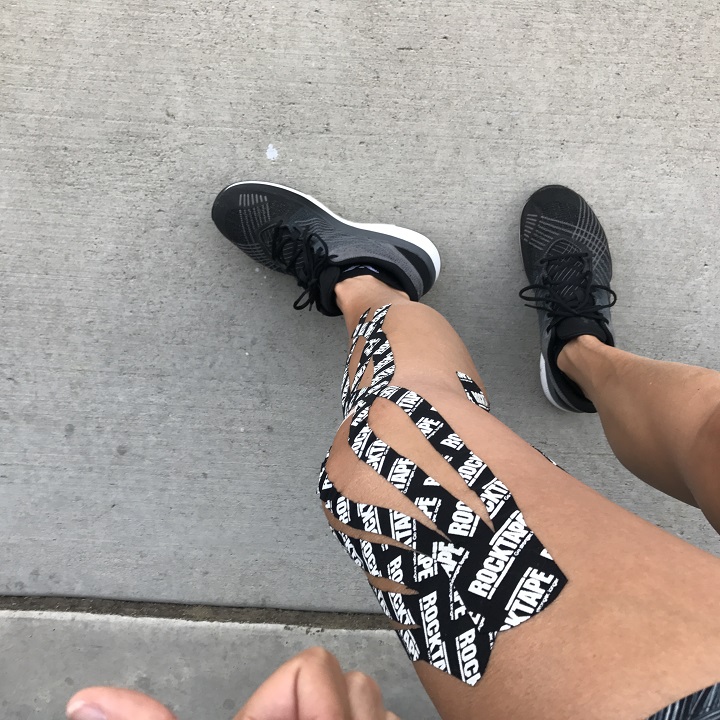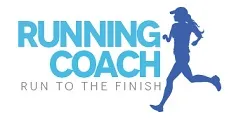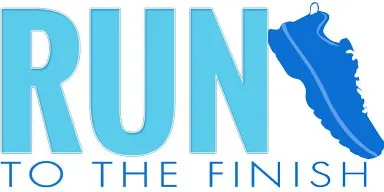By using knee taping for stability, you can not only help provide stability to your knee but also relieve pain. But the exact reason why you’re choosing to tape your knee and the type of type you’re using affects how to go about it. I’ll show you how to apply it and why it works.
It takes a lot of trial and error to apply kinesiology tape so that it works properly (in this case, to provide knee stability). But with a good video (below), you can avoid wasting tape and get it right on the first try. I’ve had literally hundreds of people tell me it helped.
Here I’ll give you step-by-step taping method that helps with knee stabilization. Useful if you’re having pain while walking, running or playing other sports.
As always, I recommend seeing a Doctor or Physical Therapist to find out the primary cause of your pain. Taping it may only be masking an issue that you need to resolve.
Checkout some of the most common causes of knee pain from running >>
Types of Knee Tape
The two main kinds of Kinesiology tape that are used for knee stability:
Rigid Tape
As the name suggests, this type of tape doesn’t stretch and is meant to reduce movement as much as possible. This is generally that white tape you see athletic trainers using to wrap something like a NFL player’s ankle during a game.
The goal is to really firm up the area and reduce movement.

Elastic Tape
This type of tape, also known as Kinesio tape (KT Tape or Rock Tape), is intended to be the same weight and thickness as your skin. It’s made up of stretchable cotton with a sticky side. You’ve probably seen brightly colored tape on athletes during races and games.
Kinesio tape provides stability while allowing for a greater range of motion than rigid tape, since often restricting a joint from moving might make it stiffer.
It helps tissue move more smoothly over the muscles and helps with pain relieve for common injuries.
My recommendations:
- Rock Tape H2O – While you may not be swimming, I’ve just found the waterproof to stay on for a REALLY long time. Lots of showers, sweaty runs, etc and I’d rather put it on once than need to repeat constantly.
- KT Tape Pro Extreme – Same idea I just found the staying power to be longer and pre-cut strips are a time saver.
I have tried the store brand when I was in a pinch while traveling and it stayed on for a day. So if you really only need it for like a single use, go for it. But I’d spend more for the lasting power.
Does KT Tape Help Heal Knee Pain?
Nope. Taping is not providing any healing powers. However, by stabilizing a knee when it’s inflammed or rubbing because of poor movement, you are going to give it a chance to begin recovering by stopping the ongoing irritation and inflammation.
In nearly every case, you need to be doing some kind of Physical Therapy alongside the taping to assist in long term recovery.
If you need a place to start, here are some great Meniscus tear strengthen exercises >>
Applying Kinesiolgy Tape for Knee Stability
Before applying the tape, you want to make sure that your skin is dry and lotion free.
TIP: Try cleaning the skin with hand sanitizer or rubbing alcohol, this will ensure it sticks well and stays on for days! Mine will stay on over a week with daily showers.
Also, avoid touching the sticky part of the tape because the oils from your hands will remove the adhesive. Since you will be able to wear the tape for a few days, cut it to size and round the corners to avoid the tape catching on your clothing.
How Do You Tape a Knee for Meniscus Pain?
This video shows the exact method I used prior to getting knee surgery in 2017. It allowed me to keep running as we worked through options and PT to ensure a correct diagnosis.
Here’s a quick look at the steps:
- Sit at a 45 degree angle
- Holding the ends, twist and rip through the middle of the first piece of tape.
- Pulling until the tape is stretched to 100%, loosen up to 80% and apply under the kneecap.
- Take a second piece of tape and repeat applying slightly below the original piece of tape.
- The final piece of tape will be the longest so that it can wrap laterally for outer knee pain.
- Using four fingers measure the distance from the knee cap and anchor the tape from the spot where your top finger lands on your thigh
- Stretch this piece of tape to 100% then release to 25%, laying the tape down along the outer part of your knee
- Pull the last part of the tape out to 100% then release to 25% and bring around the bottom of the kneecap anchoring down to the inside of the knee
Is KT Tape Better Than A Knee Brace?
Braces and compression sleeves can provide support, but constantly move around while exercising or limit movement. The kinesiology tape helps provide support on a specific spot and if applied right can stay on for days!
Which is to say that both have their place depending on what you’re dealing with. I have leaned heavily in to tape because I like the way it allows us to move and it’s easier to wean yourself off of the tape than a brace in some cases.
However, if what you need is to completely reduce movement or improve knee tracking, then a brace is likely the better choice to start with.
Applying Kinesiology Tape for Other Knee Pain
If you’re suffering from knee arthritis, runner’s knee (patellofemoral pain syndrome), or chondromalacia patella, then you’ll need apply the tape a little bit different. Some will use rigid tape instead of KT tape, however, my Physical Therapists have always leaned towards the flexibility and that’s what I recommend.
This method is commonly known as the McConnell technique. Here’s how to do it:
- Place your leg in front of you, slightly bent and extended out.
- To protect your skin, wrap two pieces of adhesive gauze around your kneecap.
- Begin the tape strip at the middle of the kneecap and pull it over the kneecap toward the inside part of your knee.
- Push your inner knee soft tissue toward your kneecap.
- Attach the tape to the inside of the kneecap.
How to Remove Knee Tape
Knee tape tends to adhere pretty well to the skin in order to work. Consider the following when it comes time to remove it:
How to Remove Kinesiology Tape
One of the best tips I got was to take a long very hot shower, rub some soap on the area to try and loosen it up and then I will hold my skin and pull. If it’s still stuck on there well it may sting a tad, but often I leave it on long enough that it quickly comes off.
- Apply Oil: The adhesive can be loosened with baby oil or olive oil. Rub oil on the tape, then remove it in the shower after 15 to 30 minutes.
- Remove Slowly: Avoid removing the tape too quickly, since this could irritate or injure your skin.
- Correct Direction: When removing the tape, do it in the direction of your hair growth. This will help reduce irritation to the skin and hair follicle.
- Tug On Skin: Gently tug on the skin when peeling the tape with your other hand. This should make it easier while reducing discomfort.
Do you need to shave before applying KT Tape?
No, it will stick just fine to hair.
But yes, removal is going to be a lot less pleasant. This is a good reason to leave it on as long as possible so that adhesive has broken down and is more willing to let go easily.
How to Remove Rigid Tape
- Warm Bath: A warm bath can help break down the adhesive in rigid tape, allowing it to come off with more ease.
- Apply Lotion: You can also apply some body lotion on the sticky backing to help loosen it.
- Ice: Applying an ice pack can also release the tape from your skin.
Is Kines
Looking for more knee pain tips to help you keep going?
- Best Knee Brace for Running
- How to exercise with knee pain
- 10 Knee Pain Relief Techniques
- Best Running Shoes for Knee Pain
Other ways to connect with Amanda
Instagram Daily Fun: RunToTheFinish

Facebook Community Chatter: RunToTheFinish



 Phoenix Mesa Marathon and Half Marathon Review and Tips
Phoenix Mesa Marathon and Half Marathon Review and Tips